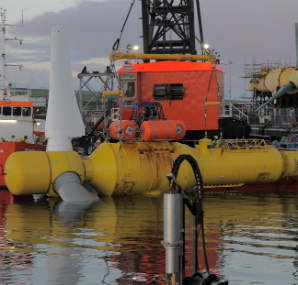
Alstom and ScottishPower Renewables have signed a memorandum of understanding to incorporate Alstom’s tidal power devices in the Sound of Islay project.
The tidal array, between the islands of Islay and Jura on the west coast of Scotland, will include up to four of Alstom’s 1 MW tidal devices, one of which is currently on test at the European Marine Energy Centre in Orkney.
The new development is expected to result in the Sound of Islay project’s becoming the largest tidal array in the world, capable of generating up 10 MWe when fully operational.
The Islay programme remains on schedule for deployment of the first unit in late 2015, with full site deployment during 2016. Operations are planned for 25 years and the demonstration project is anticipated to be the launch pad for future larger scale sites around the Scottish coast, with ScottishPower Renewables working on plans for a potential 95MW tidal project off the north coast of Caithness at Duncansby.
ScottishPower Renewables applied to Marine Scotland to build the Sound of Islay project In July 2010 and consent was received in March 2011. Alstom’s tidal turbine consists of a three-bladed, pitch-controlled rotor, with a diameter measuring 18 metres; a standard drive-train and power electronics inside the nacelle. The 22m long nacelle is installed onto a separate seabed-mounted foundation and weighs less than 150 tonnes. This tidal stream turbine has a number of notable features: First, it is simple, and easy to transport. Its buoyancy means that it is easily installed and retrieved in a single tidal cycle using small vessels, reducing installation and maintenance costs. Secondly, it has an ‘intelligent’ nacelle. Thrusters rotate the nacelle to reflect the direction of the tide, managing ebb and flood tides as well as maximising energy production. Thirdly, turbine blade pitching can be altered to control load on the turbine and optimise use of the tidal conditions locally.






